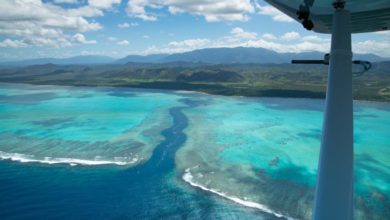Better to be on the mountain, than under it – 3 golden rules of mountaineering

You’ve probably seen the circulating meme outlining the three rubrics of mountaineering: never underestimate a climb because it is always further, taller and harder than it looks. These maxims will ring true on any mountaineering expedition especially when emotions run high during a summit attempt.
High-altitude mountaineer expert, Soren Kruse Ledet, shares his tips on how climbers can best approach mountain peaks and ways to cope in overwhelming situations.
[unitegallery 2]Rule 1: It’s always further than it looks
Audacious treks on remote trails can place you under variable weather conditions for up to eight to 12 hours a day; and depending on the region and grade of the trip, some expeditions will involve travelling on snow and ice. So, it can be particularly challenging when also carrying up to 12-15 kilograms of gear.
Adverse weather conditions when trekking, hiking and camping in remote areas is to be expected, so your level of fitness and comfort is important during the feat of expeditions. However, Soren says that being realistic about your capabilities and your goals is much more critical.
“So much of what you do isn’t just physical, it’s psychological as well,” he explains. “You don’t want to necessarily talk about the summit from day one. For a leader, what’s important is that everyone acclimatises right, then you slowly, gradually build it up, otherwise it becomes too difficult and too psychologically daunting.”
What’s the best approach?
Travellers should fortify climbs and try not get ahead of themselves emotionally. While reaching the summit calls for celebrations – with a pic or two doing the famed Hillary pose, it’s important to remember that you are only half way through your expedition. The true celebration is when you’ve finally made it back down because that’s when you are safe.
“On a lot of the climbs, and probably more so on the introductory mountaineering trips, team members tend to forget a little bit about all the pain and suffering; all the hardship they get in the first place, and the fact that they must get down safely from the summit,” says Soren.
Staying focused is key as most injuries and accidents happen on the descent. “People are tired, people let their guard down, and ultimately, a summit doesn’t matter if you end up falling and injuring yourself … so you want to make sure everyone gets back down and that’s when you celebrate and look back.”
Rule 2: It’s always taller than it looks
Reflecting on a trip he took in Tibet back in 2005, Soren remembers one traveller’s reaction in particular. He was on route to Cho Oyu with a group of fairly experienced climbers and once they hopped out of the truck he noticed the blood drain from one person’s face, floored by the enormity of the peak.
“I knew then and there that he psyched himself out of it,” recalls Soren. “I thought to myself, he’ll probably never really go high on the mountain because psychologically he was beaten already.”
What’s the best approach?
Regardless of whether it’s Everest or Mera Peak, dividing the mountain into sections can make the expedition feel more manageable.
“Say you get to Base Camp, that’s one summit; then you get to High Camp, that’s another one; and then hopefully you get to the actual summit, but take it one day at a time,” advises Soren.
Also, when entering high altitudes is it common for people to experience mild symptoms of AMS or altitude sickness, such as a loss of appetite, mild headaches, and disruptive sleep. All World Expedition mountaineering itineraries are created so travellers are given enough time to acclimatise.
As an entry level trip, Mera Peak for instance, provides several acclimatisation days building up to the crown. The 23-day trip gives hikers nearly two weeks of gradual ascents on the mountain before they attempt the summit. It is when your symptoms worsen that you should communicate to your leader how you are feeling during the expedition.
Rule 3: It’s always harder than it looks
One can train and prepare themselves as much as possible for a mountaineering trip, but preparedness comes with experience. How one behaves in foreign and hazardous environments can be a defining moment when attempting a summit.
“Most people do really well, and nine times out of ten the weather is ‘brochure weather’. In other words, conditions are generally favourable,” says Soren, “But it’s hard to prepare for bad weather, it has to be experienced.”
What’s the best approach?
Being practical about what you can achieve and attending introductory climb courses can make all the difference. Mountaineering programs at World Expeditions offer beginner skill-based courses, which give newcomers a solid foundation to learn basic mountaineering skills and alpine techniques from experienced experts.
The hands-on training trip takes the classroom outside where you are given the opportunity to undertake some exciting ice climbs on frozen waterfalls.
Our programs develop student’s skills in: safe ice and rock climbing, abseiling, rope work, ice axe and crampon techniques, crevasse rescue and navigation.
There are even opportunities to take on a summit after you complete a course, such as the Alpine Introduction Course and Gran Paradiso Climb, where you put your skills to the test by attempting a climb of Gran Paradiso (4061m), Italy’s highest peak.
For all our mountaineering trips, World Expeditions offer an extensive gear list to follow and before commencing a climb, a safety exercise is practiced ensuring travellers are prepped and safe.
“People react to stress and pressure in many ways and when you’re on a mountaineering trip you are often out of your depth, you are certainly out of your comfort zone. Some people deal with that quite well and some people not so well … and the ones not coping need a lot of support and help, which we offer,” says Soren.
Not for the faint hearted, travellers who embark on mountaineering trips plan to push their boundaries, but it is crucial not just to prepare yourselves physically but also mentally.
“It’s about being realistic – plan for the worst and hope for the best.”
ABOUT THE EXPERT
Soren Kruse Ledet has been leading World Expeditions’ mountaineering trips for nearly 20 years and has completed over 50 expeditions. He has summited many Himalayan peaks as well as completed a six-month traverse of Nepal. In 2019, Soren will be leading a Mountaineering Course and Pachermo Peak in Nepal, a San Valentin Expedition in Chile and the Ultimate K2 in Pakistan.



